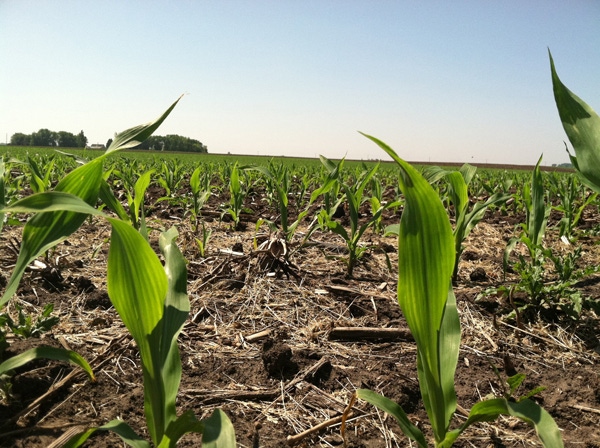April 24, 2015

Source: University of Illinois Extension and University of Minnesota Extension
*** This story has been updated by Fabian Fernandez who is a nutrient management specialist at the University of Minnesota Extension.
Fabian Fernandez, nutrient management specialist at the University of Minnesota Extension, says producers have a lot of questions when it comes to sidedressing nitrogen. The questions are usually about when to apply nitrogen, what are the best options for sidedressing and if the crop is tool tall, can nitrogen be applied "over the top."
Fernandez says most corn is around the V5-V6 stage across the country by the middle of June. Up to this point corn has taken up around 20 to 25 lbs N/acre. That’s about 10 percent of the total N it will need by the time it reaches physiological maturity in the fall.
Corn is now entering a very rapid growth phase. Between now and the time it silks, corn will accumulate an additional 100-120 lb N/ac. If the crop has insufficient nitrogen now, it will translate in reduced grain yield at harvest.
If you already applied all the nitrogen the crop will need and that nitrogen has not been lost due to excessive precipitation, you are set. But your earlier application may have been subject to loss. If you had a lot of leaching in heavily tiled fields, soils with a lot of natural drainage, or denitrification in waterlog soils, you may need to apply more nitrogen.
If additional nitrogen is needed, Fernandez offers a few reminders for growers to consider.
1. When should I apply nitrogen?
The crop needs little nitrogen during early vegetative stages to about the fifth leaf development stage. The largest portion of the total nitrogen taken up by corn occurs during the eighth leaf to VT (tasseling) development stages. Nitrogen uptake is mostly done shortly after pollination. Thus, applying N before the V8 development stage is best. Research has shown that if applications are done around V6, it is very rare to see yield loss due to N stress.
Research shows that there is little or no benefit waiting to apply nitrogen much past the V8 development stage. In fact, depending on the year, it can reduce yields. Some of our studies have shown that with split applications, delaying sidedress to V12 reduced yields compared to sidedress at V8.
Sidedress options
2. What are the best options for sidedressing nitrogen?
Injection into the soil or dribbling the nitrogen fertilizer between rows are the best ways to sidedress because this application can reduce volatilization of urea and protect the crop from foliar damage. If ammonia is used for the application, it is important to watch soil conditions to ensure that the knife track closes properly to avoid foliage damage by free ammonia escaping to the atmosphere.
When injecting or dribbling are not viable options, broadcast applications of nitrogen would be the next alternative. Urea granules will have the least impact on leaf burn compared to UAN or dry products such as ammonium nitrate or ammonium sulfate. To minimize adhesion of dry products to the leaves, it is best to apply when the foliage is dry. Remember, urea is subject to volatilization if rain does not fall within three to four days after application. As much as 30% of broadcast urea can volatilize if there is no rainfall within approximately 10 days after the application.
If UAN solution is broadcast over corn when plants are small (about 6 in.), it’s likely the damage will not result in yield loss. Even when plants are bigger (V4), the foliage damage caused by a rate as high as 90-100 lbs. nitrogen/acre typically does not cause significant yield reduction.
One way to reduce damage from UAN is to apply in advance of rain. If rain falls within a few hours after application, it will wash the fertilizer off the foliage and will also reduce the potential for volatilization of urea. If a broadcast application of UAN is the only option available, do it as soon as possible because the smaller the plant, the lesser the potential for foliar damage. If you plan to include herbicide with your UAN application, be sure you read the herbicide label first to make sure such application is allowed. Additionally, be aware that including herbicide with the UAN solution can intensify leaf burn. In Minnesota, addition of 2 lbs. atrazine/acre at a rate of more than 90 lbs. N/acre at V3 caused severe leaf burning. Applying 2 lbs. atrazine/acre at 60 lbs. N/acre causes similar leaf burning as applying 120 lbs. N/acre with UAN alone.
Over-the-top nitrogen
3. If my crop is too tall already, can I apply nitrogen “over the top?”
In some fields, crops are getting tall and some still need additional nitrogen. Application of dry products, such as ammonium nitrate and urea, “over the top” can result in foliar damage. Typically, this damage is an aesthetic concern and rarely translates into yield reduction.
Over the top applications of UAN are the least desirable way of applying nitrogen. However, if this is the only alternative and the plant needs more N, the yield benefit from the additional nitrogen will likely outweigh the leaf burn caused by the application. Research has shown yield reduction when a rate of more than 60 lbs. nitrogen/acre was applied at V8. To avoid extensive foliage damage, when nitrogen applications are needed later than V8, it’s very important to fit the high-clearance equipment with drop hoses so UAN is applied directly on the soil surface without touching the crop canopy.
“If additional nitrogen is needed, sidedress earlier rather than later in crop development if at all possible,” Fernandez says. “If you have an option on how to apply nitrogen at sidedress, choose first injection applications or dribble UAN solution between rows; second, broadcast of solid ammonium-containing fertilizers; and third, broadcast UAN solution.”
For more information about nitrogen, read the post at the University of Minnesota Extension.
You May Also Like




